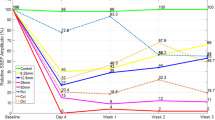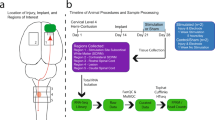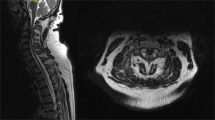Abstract
This paper presents the results of a study on the pathological changes associated with post traumatic central spinal cord necrosis.
Similar content being viewed by others
Log in or create a free account to read this content
Gain free access to this article, as well as selected content from this journal and more on nature.com
or
References
Albin, M S, White, R J, Acosta-Rua, G & Yashon, D (1968). Study of functional recovery produced by delayed localized cooling after spinal cord injury in primates. J. Neurosurg. 29, 113–120.
Allen, A R (1911). Surgery of experimental lesion of spinal cord equivalent to crush injury of fracture dislocation of spinal column: a preliminary report. J. American Med. Assoc. 57, 878–880.
Barnes, R (1948). Paraplegia in cervical spinal injuries. J. Bone & Joint Surg. 30B, 234–244.
Bedbrook, G M (1966). Pathological principles in the management of spinal cord trauma. Paraplegia, 4, 43–56.
Black, P & Markowitz, R S (1971). Experimental spinal cord injury in monkeys: comparison of steroids and local hypothermia. Surg. Forum, 22, 409–411.
Chomiak, M, Lewandowski, M, Lutnicki, W & Milart, Z (1960). Versuche zur Bestimmung der Rückenmarkbahnen beim Schaf mittels der Degenerationsmethode. Ann. Univ. M. Curie-Sklofowska, D.D. 15, 65.
Dohrmann, C J, Wagner, F C Jr. & Bucy, P C (1972). Transitory traumatic paraplegia: electron microscopy of early alterations in myelinated nerve fibers. J. Neurosurg. 36, 407–415.
Dohrmann, G J, Wick, K M & Bucy, P C (1973). Spinal cord blood flow patterns in experimental traumatic paraplegia. J. Neurosurg. 38, 52–58.
Ducker, T B & Hamit, H F (1969). Experimental treatments of acute spinal cord injury. J. Neurosurg. 30, 639–697.
Freeman, L W (1952). Return of function after complete transection of the spinal cord of the rat, cat and dog. Annals of Surgery, 136, 193.
Fried, L C & Goodkin, R (1971). Microangiographic observations in the experimentally traumatized spinal cord. J. Neurosurg. 35, 709–714.
Fulton, J F (1950). A Textbook of Physiology, 16th edition. Saunders, Philadelphia.
Green, B A, Wagner, F C Jr. & Bucy, P C (1971). Edema formation within the spinal cord. Trans. Amer. Neurol. Assoc. 96, 244–245.
Hartzog, J T, Fisher, R G & Snow, C (1969). Spinal cord trauma; effect of hyperbaric oxygen therapy. Proc. Annu. Clin. Spinal Cord Inj. Conf. 17, 70–71.
Hinwood, B, Yeo, J D & Kidman, A D (1974). Catecholamine levels in the sheep's spinal cord following trauma. Proc. of the Australian Biochemistry Society, 7, 29.
Hinwood, B G, Yeo, J D & Kidman, A D (1975). Molecular pathology of spinal injuries. The monoamine hypothesis. Proc. Aust. Biochem. Soc. 8, 60.
Kelly, D L, Lassiter, K R L, Calogero, J A & Alexander, E (1970). Effects of local hypothermia and tissue oxygen studies in experimental paraplegia. J. Neurosurg. 33, 554–563.
Kelly, D L, Lassiter, K R L, Vonsgsvivut, A & Smith, J M (1972). Effects of hyperbaric oxygenation and tissue oxygen studies in experimental paraplegia. J. Neurosurg. 36, 425–429.
Kobrine, A I & Martins, A N (1974). Spinal cord blood flow and neurological dysfunction. Lancet, April 27.
Kobrine, A I (1975). The neuronal theory of experimental traumatic spinal cord dysfunction. Surg. Neurol. 3, 21.
Kobrine, A I, Doyle, T & Rizzoli, H (1967). Further studies on histamine in spinal cord injury and post traumatic hyperemia. Surg. Neurol. 5, 101–103.
Lassek, A M (1942). The pyramidal tract; a fibre and numerical analysis in a series of non-digital mammals (ungulates). J. Comp. Neurol. 77, 399.
Locke, G E, Yashon, D & Feldman, R A et al. (1971). Ischaemia in primate spinal cord injury. J. Neurosurg. 34, 614–617.
Naftchi, N E, Demeny, M, Decrescito, V, Tomasula, J, Flamm, E & Campbell, J (1974). Biogenic amine concentration in traumatised spinal cords of cats. J. Neurosurg. 40, 52–57.
Osterholm, J L, Mathews, G F & Irvin, J D et al. (1971). A review of altered norepinephrine metabolism attending severe spinal injury: results of alpha methyl tyrosine treatment and preliminary histofluorescent studies. Proc. Veterans Admin. Spinal Cord Inj. Conf. 18, 17–21.
Osterholm, J L (1974). The pathophysiological response to spinal cord injury—current status. J. Neurosurg. 40, 5–33.
Osterholm, J L & Mathews, G J (1972). Altered norepinephrine metabolism following experimental spinal cord injury. 1. Relationship to haemorrhagic necrosis and post-wounding neurological deficits. J. Neurosurg. 36, 386–394.
Osterholm, J L & Mathews, G J (1972). Altered norepinephrine metabolism following experimental spinal cord injury. II. Protection against traumatic spinal cord haemorrhagic necrosis by norepinephrine synthesis blockade with alpha methyl tryosine. J. Neurosurg. 36, 395–401.
Palmer, A C (1965). Introduction to Animal Neurology, 1st edition. Blackwell Scientific Publications, Oxford.
Salthouse. (1965). Luxol fast blue for staining phospholipids. J. Histochem. Cytochem. 13, 133.
Schneider, R D (1958). The syndrome of acute central cervical spinal cord injury. J. Neurol. Neurosurg. Psychiat. 21, 216.
Tator, C H (1972). Acute spinal cord injury: a review of recent studies of treatment and pathophysiology. C.M.A. Journal, July 22, 107, 143–150.
Tomasula, J J, Decrescito, V & Goodkin, R et al. (1969). A survey of the management of experimental spinal cord trauma. Proc. Annu. Clin. Spinal Cord Inj. Conf. 71, 12–16.
Turnbull, I M (1971). Microvasculature of the human spinal cord. J. Neurosurg. 35, 141–147.
Vise, W M, Yashon, D & Hunt, W E (1974). Mechanisms of norepinephrine accumulation within sites of spinal cord injury. J. Neurosurg. 40, 76–82.
Wagner, F C Jr., Green, B A & Bucy, P C (1971). Spinal cord edema associated with paraplegia. Proc. Clin. Spinal Cord Injury Conf.
White, R J & Albin, M S (1970). Spine and spinal cord injury. In: Gurdjian, E.S., Lane, W. A., Patrick, L. M., (eds): Impact Injury and Crash Protection. Charles C. Thomas, Publisher, Springfield, Ill., pp. 63–85.
Yeo, J D, Payne, W & Collins, L T (1971). Controlled experimental contusion of the spinal cord of sheep. Proceedings of the Surgical Research Society of Australasian Scientific Meeting. Aust. & N.Z. J. Surgery, 41, no. 1, 89–90.
Yeo, J D & Collins, I (1974). The place of isotope myelography in the definition of spinal cord swelling following trauma. Aust. & N.Z. J. Surgery, 44, no. 3, 292–298.
Yeo, J D & Payne, W H (1975). Sequential pathological changes seen in controlled trauma to the spinal cord of the sheep. Ann. Meeting Royal College of Pathologist. of Aust., Aukland, N.Z. J. Pathology, 7, no. 1 66.
Yeo, J D, Payne, W, Hinwood, B & Kidman, A (1975). The experimental contusion injury of the spinal cord in sheep. Paraplegia, 12, 275.
Yeo, J D, Mckenzie, B, Hinwood, B & Kidman, A (1976). Treatment of paraplegic sheep with hyperbaric oxygen—a preliminary report. Med. J. of Aust. 1, 538–540.
Zivin, J A, Doppman, J L, Reid, J L, Tappaz, M L, Saavedra, J M, Dopin, I J & Jacobowitz, D M (1976). Biochemical and histochemical studies of biogenic amines in spinal cord trauma. Neurology, 26, 99–107.
Author information
Authors and Affiliations
Rights and permissions
About this article
Cite this article
Yeo, J., Stabback, S. & McKenzie, B. Central necrosis following contusion to the sheep's spinal cord. Spinal Cord 14, 276–285 (1977). https://doi.org/10.1038/sc.1976.45
Issue date:
DOI: https://doi.org/10.1038/sc.1976.45



